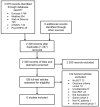Do behaviour-change techniques contribute to the effectiveness of exercise therapy in patients with intermittent claudication? A systematic review
- PMID: 23664887
- PMCID: PMC4033840
- DOI: 10.1016/j.ejvs.2013.03.030
Do behaviour-change techniques contribute to the effectiveness of exercise therapy in patients with intermittent claudication? A systematic review
Abstract
This systematic narrative review of randomised controlled trials (RCTs) identifies and evaluates the efficacy of behaviour-change techniques explicitly aimed at walking in individuals with intermittent claudication. An electronic database search was conducted up to December 2012. RCTs were included comparing interventions incorporating behaviour-change techniques with usual care, walking advice or exercise therapy for increasing walking in people with intermittent claudication. Studies were evaluated using the Cochrane Collaboration risk of bias tool. The primary outcome variable was maximal walking ability at least 3 months after the start of an intervention. Secondary outcome variables included pain-free walking ability, self-report walking ability and daily walking activity. A total of 3,575 records were retrieved. Of these, six RCTs met the inclusion criteria. As a result of substantial heterogeneity between studies, no meta-analysis was conducted. Overall, 11 behaviour-change techniques were identified; barrier identification with problem solving, self-monitoring and feedback on performance were most frequently reported. There was limited high-quality evidence and findings were inconclusive regarding the utility of behaviour-change techniques for improving walking in people with intermittent claudication. Rigorous, fully powered trials are required that control for exercise dosage and supervision in order to isolate the effect of behaviour-change techniques alongside exercise therapy.
Copyright © 2013 European Society for Vascular Surgery. Published by Elsevier Ltd. All rights reserved.
Figures

Similar articles
-
Exercise for intermittent claudication.Cochrane Database Syst Rev. 2017 Dec 26;12(12):CD000990. doi: 10.1002/14651858.CD000990.pub4. Cochrane Database Syst Rev. 2017. PMID: 29278423 Free PMC article.
-
Supervised exercise therapy versus home-based exercise therapy versus walking advice for intermittent claudication.Cochrane Database Syst Rev. 2018 Apr 6;4(4):CD005263. doi: 10.1002/14651858.CD005263.pub4. Cochrane Database Syst Rev. 2018. PMID: 29627967 Free PMC article.
-
Mobile health technologies to improve walking distance in people with intermittent claudication.Cochrane Database Syst Rev. 2024 Feb 14;2(2):CD014717. doi: 10.1002/14651858.CD014717.pub2. Cochrane Database Syst Rev. 2024. PMID: 38353263 Free PMC article.
-
Supervised exercise therapy versus non-supervised exercise therapy for intermittent claudication.Cochrane Database Syst Rev. 2013 Aug 23;(8):CD005263. doi: 10.1002/14651858.CD005263.pub3. Cochrane Database Syst Rev. 2013. Update in: Cochrane Database Syst Rev. 2018 Apr 06;4:CD005263. doi: 10.1002/14651858.CD005263.pub4. PMID: 23970372 Updated.
-
Interventions for promoting habitual exercise in people living with and beyond cancer.Cochrane Database Syst Rev. 2018 Sep 19;9(9):CD010192. doi: 10.1002/14651858.CD010192.pub3. Cochrane Database Syst Rev. 2018. PMID: 30229557 Free PMC article.
Cited by
-
Satisfaction and Acceptability of Telemonitored Home-Based Exercise in Patients With Intermittent Claudication: Pragmatic Observational Pilot Study.JMIR Rehabil Assist Technol. 2021 Mar 22;8(1):e18739. doi: 10.2196/18739. JMIR Rehabil Assist Technol. 2021. PMID: 33749616 Free PMC article.
-
WalkingPad protocol: a randomized clinical trial of behavioral and motivational intervention added to smartphone-enabled supervised home-based exercise in patients with peripheral arterial disease and intermittent claudication.Trials. 2022 Apr 18;23(1):326. doi: 10.1186/s13063-022-06279-9. Trials. 2022. PMID: 35436974 Free PMC article.
-
Effect of a Home-Based, Walking Exercise Behavior Change Intervention vs Usual Care on Walking in Adults With Peripheral Artery Disease: The MOSAIC Randomized Clinical Trial.JAMA. 2022 Apr 12;327(14):1344-1355. doi: 10.1001/jama.2022.3391. JAMA. 2022. PMID: 35412564 Free PMC article. Clinical Trial.
-
Motivating Structured walking Activity in people with Intermittent Claudication (MOSAIC): protocol for a randomised controlled trial of a physiotherapist-led, behavioural change intervention versus usual care in adults with intermittent claudication.BMJ Open. 2019 Aug 24;9(8):e030002. doi: 10.1136/bmjopen-2019-030002. BMJ Open. 2019. PMID: 31446416 Free PMC article.
-
Behaviour change interventions to promote physical activity in people with intermittent claudication: the OPTIMA systematic review.Health Technol Assess. 2025 May;29(18):1-142. doi: 10.3310/ZBNG5240. Health Technol Assess. 2025. PMID: 40421965 Free PMC article.
References
-
- Regensteiner JG, Hiatt WR, Coll JR, Criqui MH, Treat-Jacobson D, McDermott MM, et al. The impact of peripheral arterial disease on health-related quality of life in the Peripheral Arterial Disease Awareness, Risk, and Treatment: New Resources for Survival (PARTNERS) Program. Vasc Med. 2008;13(1):15–24. Epub 2008/03/29. - PubMed
-
- McDermott MM, Greenland P, Ferrucci L, Criqui MH, Liu K, Sharma L, et al. Lower extremity performance is associated with daily life physical activity in individuals with and without peripheral arterial disease. J Am Geriatr Soc. 2002;50(2):247–55. Epub 2002/05/25. - PubMed
-
- Gardner AW, Montgomery PS, Killewich LA. Natural history of physical function in older men with intermittent claudication. J Vasc Surg. 2004;40(1):73–8. Epub 2004/06/26. - PubMed
-
- Norgren L, Hiatt WR, Dormandy JA, Nehler MR, Harris KA, Fowkes FG, et al. Inter-Society Consensus for the Management of Peripheral Arterial Disease (TASC II) Eur J Vasc Endovasc Surg. 2007;33(Suppl 1):S1–S75. Epub 2006/12/05. - PubMed
-
- Hirsch AT, Haskal ZJ, Hertzer NR, Bakal CW, Creager MA, Halperin JL, et al. ACC/AHA Guidelines for the management of patients with peripheral arterial disease (lower extremity, renal, mesenteric, and abdominal aortic): a collaborative report from the American Associations for Vascular Surgery/Society for Vascular Surgery, Society for Cardiovascular Angiography and Interventions, Society for Vascular Medicine and Biology, Society of Interventional Radiology, and the ACC/AHA Task Force on Practice Guidelines (writing committee to develop guidelines for the management of patients with peripheral arterial disease)--summary of recommendations. J Vasc Interv Radiol. 2006;17(9):1383–97. Epub 2006/09/23. - PubMed
Publication types
MeSH terms
Grants and funding
LinkOut - more resources
Full Text Sources
Other Literature Sources
Research Materials
Miscellaneous

